1920 – 1966
Enos Namatjira was unsurpassed in revealing the country in a seeming harmony of spiritual reverence and unspoken meaning so that we can perhaps share some sense of the timelessness of the Dreaming. He painted with traditional pride and sensitive solemnity. His topography and vegetation is gently animated. The country is also gently luminous. Significantly, totemic features like ranges were portrayed to appear to be moving along the landscape relative to the surrounding country, perhaps reflecting the artist’s understanding of the travels of totemic creation ancestors.
Enos Namatjira was a founder and master of the Hermannsburg School. Albert Namatjira’s eldest son was born ‘out bush’ and his exact date of birth is unknown. Albert turned eighteen in July of 1920, the year of Enos’ birth and his mother Rubina turned seventeen. Enos was Western Arrernte, Subsection (Skin) Peltharre). His mother Rubina was of the Kukatja people, whose country is west of Ntaria/Hermannsburg in the area that includes Papunya and Haasts Bluff.
When Rex Battarbee returned to Hermannsburg (from his home in Warrnambool, Victoria) in June and July 1938, Albert was eagerly waiting to go out bush painting with Battarbee along with Enos, who helped with the camels.
During the important painting trip Battarbee’s diaries occasionally refer to Enos hunting, such as shooting a wallaby with Rex’s .22 small calibre rifle, or catching perch which was cooked in ashes, and a black wild duck (for a change of meat). In this way Enos, at 17 years was familiar indirectly with watercolour painting. Rex Batterbee later saw Enos painting with Albert, and his brothers Oscar and Ewald in 1939. [1]
Before Enos began to paint on paper he was an expert in drawing animals in action, a talent encouraged in the Mission schoolroom. His father, Albert, also sketched animals in motion in 1934.
In 1940 Enos was one of a small group of young men who attended Rex Battarbee’s drawing lessens at the Mission, which were instigated by Pastor Albrecht. Battarbee noted in his diary in August 1940 that ‘Enos brought in quite a good painting of Mt Hermannsburg…’
In December 1942 Rex noted in his diary that Enos brought in painted boomerangs today, only 24 hours after he received them and got two pounds six shillings (£4/6/-) for them. Enos was very productive. Enos served during the War in the Aboriginal Labour Gang, while also decorating artefacts for sale to military service-men and occasional visitors. Battarbee noted in his diary on 2.2.43 that Enos had said that he did not like being in the Army as there was not enough pay and too much work.
Enos’ early paintings in watercolour on paper featured moving animals in a narrow band as on a boomerang souvenir, but in transitioning to wider compositions on paper, he placed an iconic hill behind the animals, in order to portray distance. A foreground was then developed in the space in front of the animals to increase perspective. These horizontal bands of foreground, mid ground, distance and far distance dominated his early compositions.
Enos married a Pitjantjara woman, Ruby Moida (Muwitja) who was born 1926/28. After his marriage he spent much time away from Hermannsburg. His son Gabriel, who became an artist, was born 20.1.1942 and died in May 1969 aged 27 years. Enos and Ruby’s daughter, future artist Jillian, was born 15.8.1949 at Areyonga in Pitjantjara country.
The settlement at Areyonga was out west of Hermannsburg in the Mission’s area of influence. Alice Springs had its attractions, especially after access to alcohol was available. At the time of the 30 June 1966 Census of Wards, Enos and Ruby were at No 1 Artists Camp Alice Springs. Enos died some two months later in Alice Springs (5 September 1966). His body was found ‘near the Gap’. [2]
Enos would have been camping in cold temperatures at night and Enos’ early death age 46 may have been connected to severe living conditions also. The average monthly minimum temperatures at Alice Springs (airport) in 1966 in June were 3 to 4 degrees celsius, in July 4 to 5 degrees celsius, and in August 4.5 to 9 degrees celsius. (Historical Weather for 1966 in Alice Springs, Australia)
Enos transitioned in stages from artefact decoration with animals to watercolour painting of country on paper as demonstrated by paintings in the collection of the National Gallery of Australia. For example,
Not titled [Emus and dog] (est. 1943-45; watercolour on paper; 25 x 35.4 cm; NGA 66118 87.317)
This early landscape, seems to be a first stage in transitioning from a narrow boomerang shaped decoration by adding landscape features behind. Note dot type of infill in mid and foreground. It is a horizontal landscape in two colours of alizarin crimson and blue with black (from mixing the two colours). The composition includes sophisticated and well-practised cartoon like animals. The animals are active and the country appears as the still back-drop of a stage.
Kangaroos and emu (est. 1943-45; watercolour on paper; 25 x 35.4 cm; NGA 66127 87.320)
This seems to be a second stage in the transition from a boomerang style decoration, now with a described foreground in front of the cartoon like animals and the feature hill behind. The big tree and small tree unite the horizontal zones. Distance is suggested through the obvious horizontal bands from the foreground up to the horizon.
In Enos’ next big step he omitted the animals and created scenes in which the hills and cliffs seemed animate and appeared to be moving in relation to other motionless features such as the flat earth. The whole landscape then became the actor. Enos freed himself of the dominance of the flat horizontal bands by emphasising angles in the scenes he painted, such as slanting lines of hills and plains. The angled plains and rows of hills were painted to suggest movement and energy. He sometimes included features such as face-like cliffs appearing to interact with a row of cliffs opposite.
Enos started to paint in watercolour seriously in 1945. In some paintings the big trees appear personified as human observers or perhaps spiritual companions of the animate totemic hill, which is the subject of the painting. Such a big tree may be marked clearly with a tribal cicatrice (scar from removal of bark for traditional utensil purposes), suggesting the use of the tree in the production of objects on one hand, as well as beings of untold importance, on the other hand. He adorned features with parallel lines and parallel rows of dots, so familiar to traditional people.
Enos described the country as if sharing his adoration of the country to which he belonged. In traditional sentiment Enos himself was the country. He painted thoughtfully, carefully and without haste and so was not a prolific painter. Enos had up to twenty years of serious watercolour painting from when he started seriously in 1945. His busiest period was from 1957 to 1960, peaking during 1958 and 1959. Only the occasional painting was like his father’s work, such as;
River Gum MacDonnell Ranges (1945; watercolour on paper. MAGNT NAM-0182)
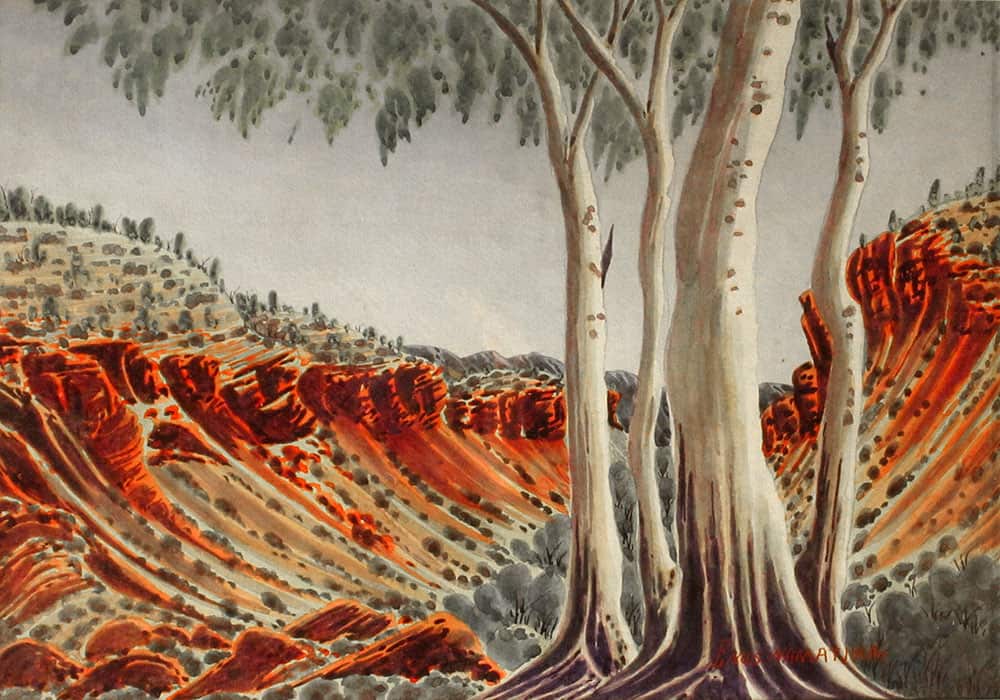
Ormiston Gorge
Enos Namatjira
• • •
est. 1945-50
Watercolour on paper
24 x 35 cm
Beverley Castleman Collection
BDC-EnN-18
In this early painting the parallel lined walls of the gorge swoop up to support animate red cliffs with face-like cliffs facing each other. The big foreground trees rise up like observers of the action. This is the author’s earliest painting by Enos.
The active elements have replaced the animals in transitional paintings. The elegant design employs parallels inspired by the use of parallels on implements such as hunting boomerangs before they were decorated for tourists (as illustrated in Spencer and Gillen). Dots are used copiously for decorative effect. Alizarin crimson appears to be the red of the cliffs and of hill bases and rocks. The artist had reached a refinement of composition and colour.
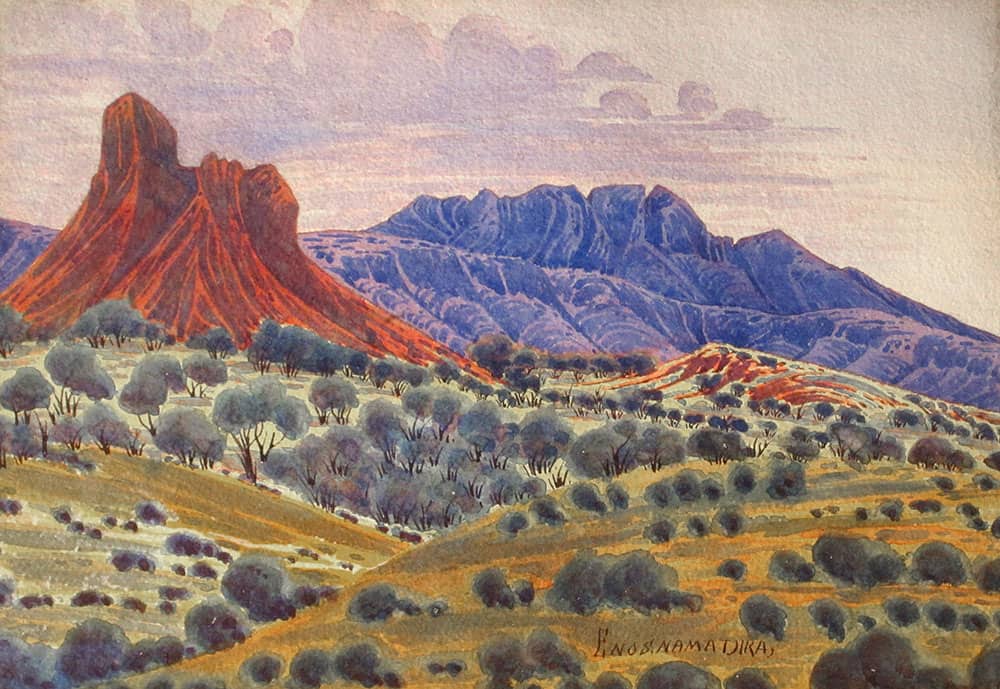
Mount Liebig, MacDonnell Ranges
Enos Namatjira
• • •
est. 1948-52
Watercolour on paper
25 x 36 cm
Beverley Castleman Collection
BDC-EnN-25
In this wet season composition, the artist’s interest is in the curious monolith in the mid ground and its relationship to the mountain beyond. Parallels emphasise the drama of the site. Subtle horizontal colour fields help achieve recession.
Mt Liebig is about 8 – 10 kilometres south west of Papunya and about a similar distance north west of Haasts Bluff. By 1959 Enos started to strengthen his horizontal compositions with angled structures of hills and rows of blob trees, depicting plains on an angle, usually slanting gently from left down to right.
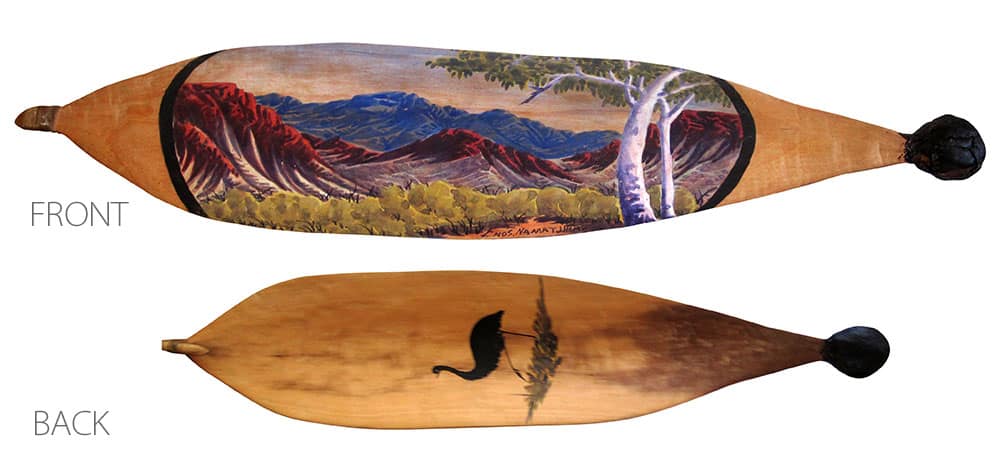
Ghost Gums, MacDonnell Ranges
Enos Namatjira
• • •
est. 1957-62
Watercolour on convex side of beanwood woomera
Length 49 cm
Emu drawn in black on concave side
Beverley Castleman Collection
BDC-EnN-21
Enos used an artefact to express his reverence for the country of which he was a part. He emphasised his reverence for the scene with the emphatic black lines on each side, forming an oval shape coinciding with the shape of the sacred stone or wooden tjurunga, which would be given to a thirteen year old boy at his initiation. The sacred tjurunga would have traditional totemic symbols, rather than a pictorial scene.
The oval area was prepared sensitively with a glaze of opaque white paint, which was wiped while wet to allow the grain in the sky area to glow as suggested clouds with a glaze of blue towards the top and the natural amber colour of beanwood toward the horizon behind the blue hills, suggesting sunset. The light source is from a low point to the right of the viewer. Enos signed this painting lower right of centre in an area of wood left unpainted like the raw beanwood outside the oval of the painting.
The wooden ground is a definite part of the painting in a way not available from paper. The animate red cliff-tops seem face-like and the mature tree and its younger companion survey and frame the scene. The luminous small foreground trees seem animate. A lemon under-wash was applied to backlight the lower horizontal screen of trees and backlight the foliage of the big trees. A thin lemon under wash was applied before the ultramarine paint on the distant hills. A thin ultramarine wash was applied on the sky. Alizarin crimson was used on the mid-ground range of hills and as a thin wash on the tiny plain in front of the foreground band of small blob trees.
There was overpainting with white on the big tree trunks and to highlight the bases to the crimson topped hills on the left side of the painting. Fine black painted line work was applied for small tree trunks and dead branches on the row of blob trees. The emu verso was painted in fine black line work with a dot of white for the eye.
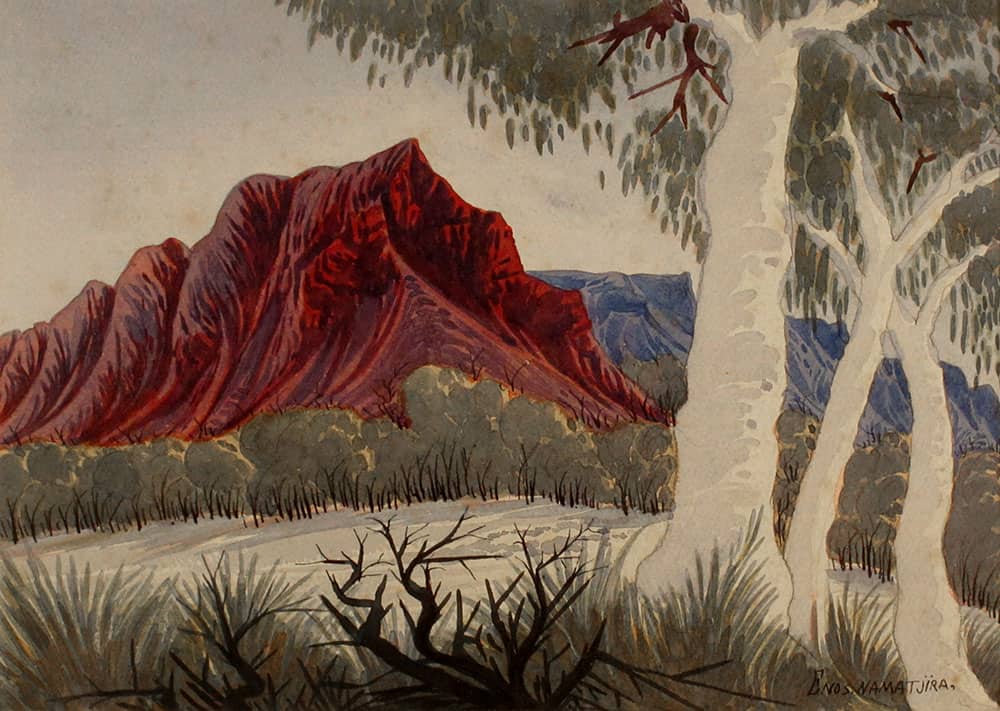
MacDonnell Ranges
Enos Namatjira
• • •
est.1958-59
Watercolour on paper
25 x 34.8 cm
Beverley Castleman Collection
BDC-EnN-01
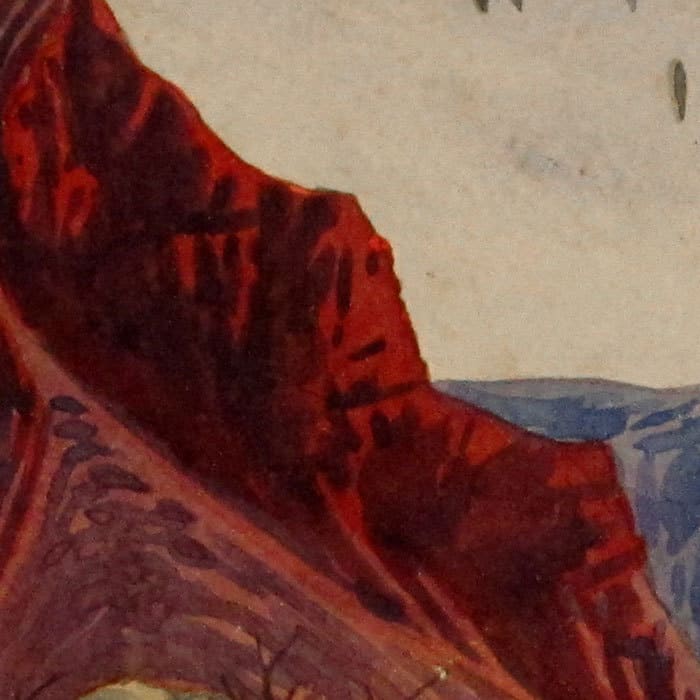
Three animate trees observe the animate ancestral rocky hill, which seems to include a face. Spiky black brambles form the centre of a screen as if to separate the viewer behind the space shown in the picture. The trees appear to face the hill.
The important mountain, which has face drawn on it is shown in crimson and deep purple. There are three main horizontal areas/rows in front of the subject hill. There is restrained lemon behind the two screening rows and big tree foliage.
Note: the horizontal format of its design was modified aesthetically by the riverbed slanting down to each side from the centre. The sky is of pale cobalt blue and the distant hills are of two-tone cobalt blue. The symbolic screen at bottom of the composition is of semi -transparent grey/green spiky tussocks and spiky black brambles together with three big trees at the right. The white of the riverbed and tree trunks is unpainted paper.
The bottom of hill was heavily screened by wet in wet blob trees with fine black pen drawn trunks. The pencil outlining of the main tree trunk is part of the art system. Long horizontal lines, including parallels, on subject hill are part of system. This was created carefully over more than one session.
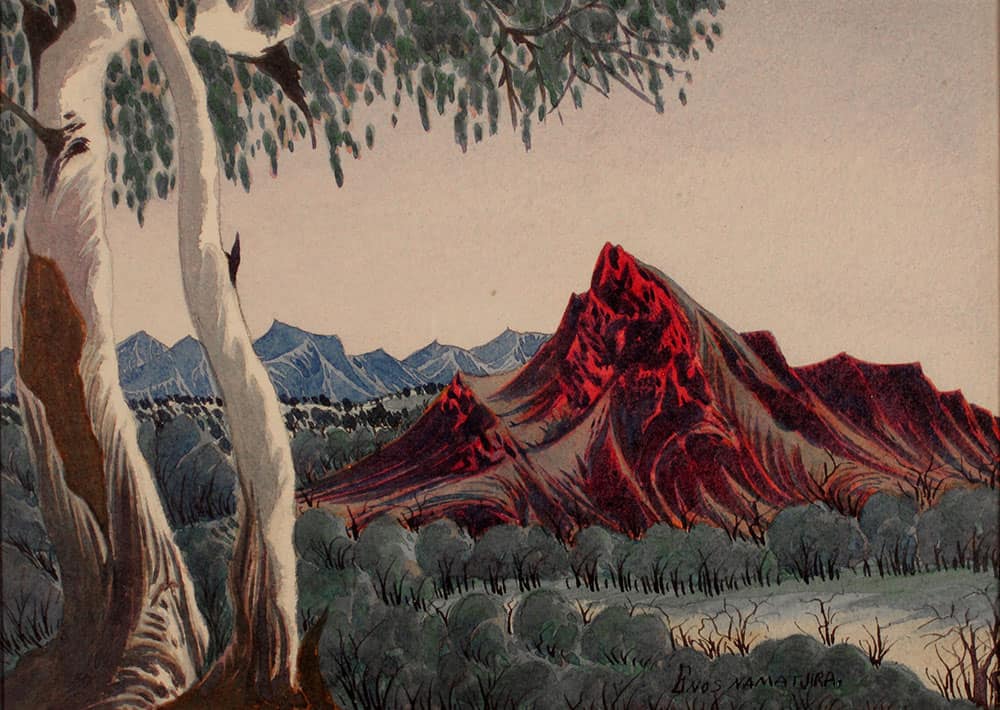
Central Australian Landscape
Enos Namatjira
• • •
est. 1958/59
Watercolour on paper
25.3 x 35.5 cm
Beverley Castleman Collection
BDC-EnN-13
This painting is about two animated trees relating to the active animated totemic hill. This is a very intimate portrayal of an important deeply revered ancestral site. Both big trees are sunlit from the right and the bright crimson of the hill appears to light the overhanging framing tree branch from below.
The mature tree has a cicatrice (scar from the removal of bark for traditional purposes). The cicatrice is surrounded by careful parallel lines and there are curved lateral parallels at the base of the tree. The scar low on the trunk of the younger tree perhaps resulted from a mishap in the sapling stage.
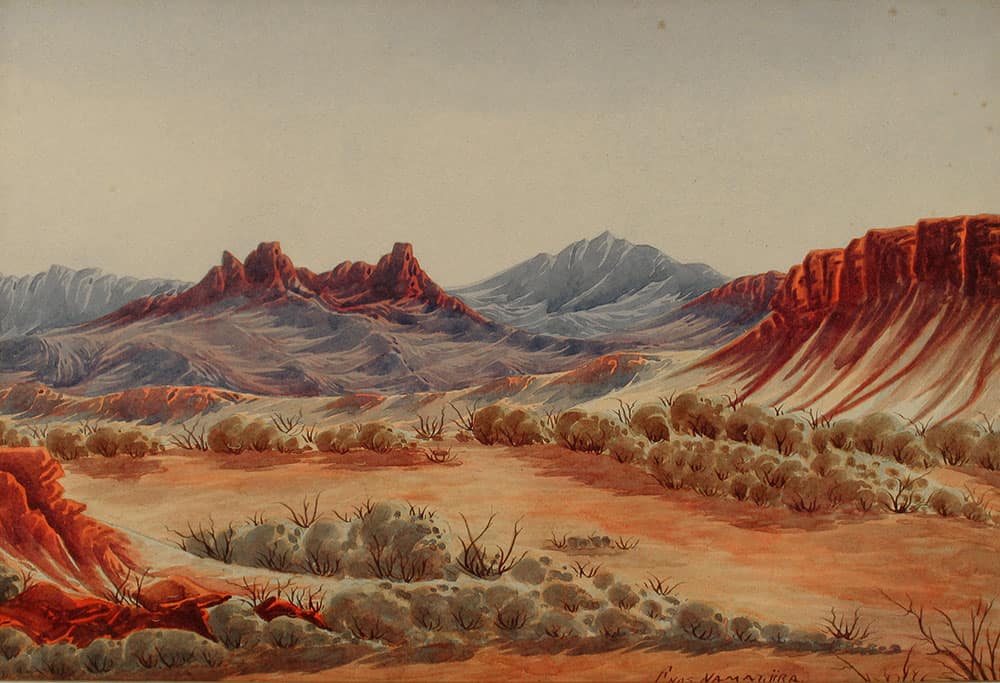
Central Australian Landscape
Enos Namatjira
• • •
1959
Watercolour on paper
33.5 x 50.5 cm
Purchase authorised 17.8.59 G Jones for District Welfare Officer
Beverley Castleman Collection
BDC-EnN-08
This is one of three paintings, which seem to be of the one large regional area, painted around the same time as if the artist was camped there for a period. Parts of the location may be archetypal, although the red detailed feature hill appears to be a particular hill, perhaps placed in the scene as an icon.
In this painting all of the hills from the left foreground outcrop to the blue distant ranges seem to be in motion, compared to the stillness of the flat mid ground and foreground strip. The red rocky cliff-tops seem suggestive of faces. The cliff-tops on the right seem to be attentive to whatever may happen in the mid-ground.
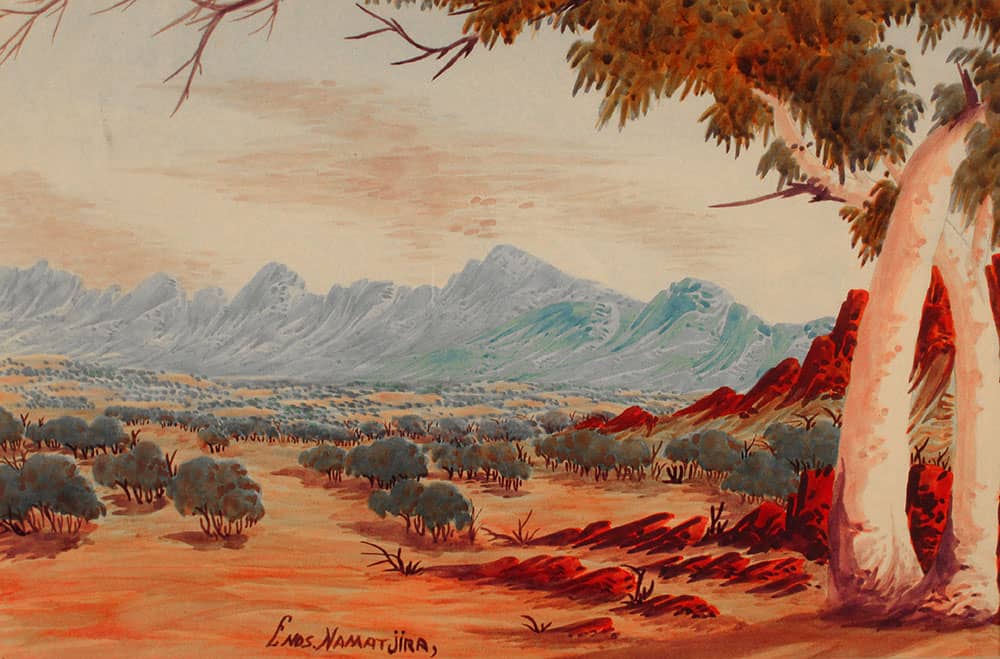
Open Plains
Enos Namatjira
• • •
est. 1963-65
Watercolour on paperboard
26.5 x 40.5 cm
Beverley Castleman Collection
BDC-EnN-04
In this fantasy/memory painting the foreground is gently angled perhaps to suggest a way through to the left of the composition. Low right red hills are schematic. Cerulean blue sky with mauve clouds. The two tone cerulean blue distant hills seem to be moving to the right relative to the plain of patterned undulating hills suggested by the lines of dots on the plain below.
Pale lemon yellow under front plain with orange stripy wash over. Brighter lemon on base of far right red rock topped hill on right. Parallels in red rocks. The distant hills and mid/foreground red hills seem to be moving to right in a system with slanting parallels. Sophisticated schematic infill. This was painted carefully over a number of sessions.
REFERENCES TO EXTERNAL TEXTS
[1] Jane Hardy, J V S Megaw and M Ruth Megaw eds., The Heritage of Namatjira: The Watercolourists of Central Australia, p162 [2] Paul G E Albrecht From Mission to Church 1877 – 2002 finke river mission, p22
